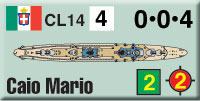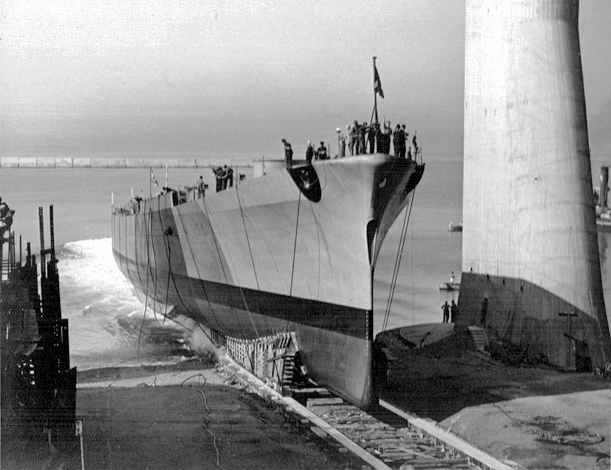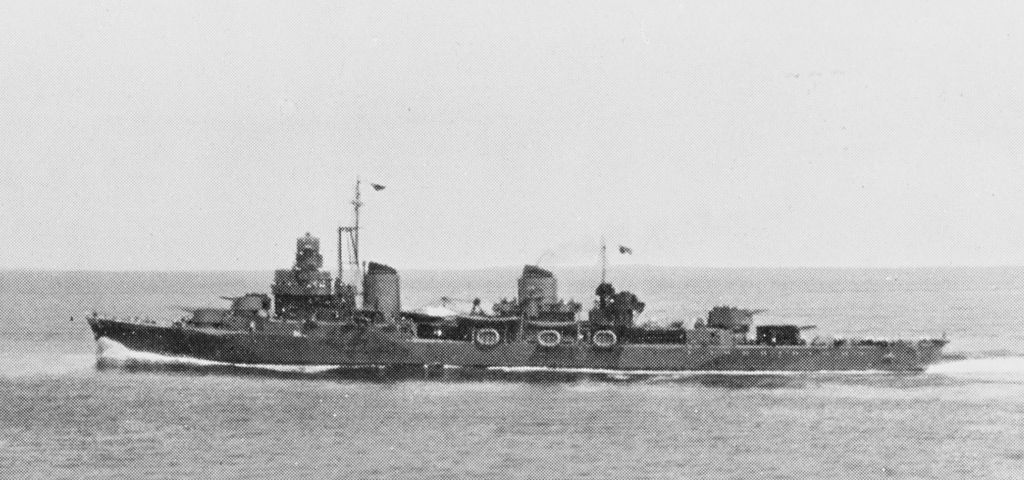La Regia Marina:
Italy’s Capitani Romani Class
by Mike Bennighof, Ph.D.
June 2020
 In the mid-1930’s, construction of the large French destroyer Le Fantasque created a huge stir in naval circles. Much larger than foreign destroyers, with an extremely high speed and heavy armament, the boat represented a revolution in destroyer design. Deeply impressed, the Red Navy’s head of shipbuilding, Alexander K. Sivkov, received permission to attempt to buy such a ship for the Red Navy. In the mid-1930’s, construction of the large French destroyer Le Fantasque created a huge stir in naval circles. Much larger than foreign destroyers, with an extremely high speed and heavy armament, the boat represented a revolution in destroyer design. Deeply impressed, the Red Navy’s head of shipbuilding, Alexander K. Sivkov, received permission to attempt to buy such a ship for the Red Navy.
Sivkov approached the French yard of A.C. France, then fitting out Le Fantasque’s sister ship, Le Triomphant, with a tender for one identical ship to be built at the Dunkerque yard and three more to be built in the Soviet Union with A.C. France’s technical assistance. The French price far exceeded what Sivkov had been authorized to spend, and he met similar problems at other French yards and at Ansaldo of Italy.
Luigi Orlando of the Italian firm OTO (Oder-Terni-Orlando) agreed to meet the Soviet price, and signed a contract with Sivkov in September 1935. OTO designed the new boat, soon named Tashkent, and laid her keel in January 1937. Slightly larger than Le Fantasque, Tashkent displaced just over 2,800 tons and made a speed of a little more than 42 knots.
 Painted sky blue to sneak through the Turkish Straits to Sevastopol disguised as a passenger ship, Tashkent greatly pleased the Red Navy. She retained her unusual color scheme and Soviet sailors named her “Blue Beauty” or “Blue Cruiser.” Sivkov did not live to see this; he had been appointed commander of the Red Banner Baltic Fleet soon after contracting for the new ship and met a firing squad in 1938 during the Great Purges. Painted sky blue to sneak through the Turkish Straits to Sevastopol disguised as a passenger ship, Tashkent greatly pleased the Red Navy. She retained her unusual color scheme and Soviet sailors named her “Blue Beauty” or “Blue Cruiser.” Sivkov did not live to see this; he had been appointed commander of the Red Banner Baltic Fleet soon after contracting for the new ship and met a firing squad in 1938 during the Great Purges.
The Soviets found that their industry could not copy the sophisticated machinery used in Tashkent, and ended up building a new local design within their capabilities rather than repeating the Italian-built boat. OTO had been up front with the Soviets about their intention to offer the design to the Royal Italian Navy, and they immediately did so. The Italian admirals also admired the Blue Cruiser, and wanted one of their own. Many of their own.
Umberto Pugliese, Italy’s leading naval architect of the time, led the team that modified the Tashkent design to Italian specifications. This would be the last ship designed by the hyper-patriotic Pugliese, who habitually donated all of his many patents to the Italian state. But Pugliese was a Jew, and under Mussolini’s new Racial Laws he was dismissed from service after finishing the new plans (unwilling to leave his beloved Italy, he fought for and would later obtain a waiver).

Launch of Cornelio Silla at Genoa, 28 June 1941.
Pugliese increased the ship’s size to accommodate a larger armament, eight main guns in twin turrets rather than the six carried by Tashkent. The new 135mm (5.3-inch) dual-purpose guns had been used in the reconstruction of the battleship Caio Duilio and many considered it the best Italian naval gun of the time, with high-angle capability and good range, but not a rate of fire really rapid enough to effectively fill the anti-aircraft role. In addition, the enlarged ship – now classed as a cruiser and therefore a “ship” rather than a “boat” – had eight 37mm anti-aircraft guns and eight more 20mm pieces.
The eight 37mm guns replaced four new-model 65mm anti-aircraft pieces, which had not completed their development. Eight torpedo tubes in a pair of four-tube mounts completed the armament. In addition, the cruisers were fitted with a pair of depth-charge throwers and two depth-charge racks, and they could carry and lay up to 136 mines.
Now displacing 3,700 tons compared to 2,800 for Tashkent, the new cruiser had new machinery, four small-tube boilers powering a set of Belluno geared turbines, rather for 110,000 horsepower. That gave the cruiser a designed speed of 41 knots, which the ships actually completed managed to exceed in service (nearly all Italian warships exceeded their designed speeds during trials, thanks to a practice of lightening their loads and over-straining the machinery).
With her impressive armament and excessive speed on a relatively small hull, something had to give and Pugliese went with a nearly unprotected ship. The new cruiser had lightweight splinter protection for her conning tower, bridge and main gun turrets, and nothing else. Though classed as a light cruiser, the new ship more closely resembled the French contre-torpilleur types. It had a much greater displacement than the French boats, but was only slightly longer and broader than Tashkent or Le Fantasque.
Impressed with the design, the Royal Italian Navy ordered a dozen of them, all laid down in September and October 1939. As the lead contractor, OTO received four of the orders, with no other shipyard getting more than two contracts. Known as the Capitani Romani class, all were named for famous Roman commanders.
Only one ship, Attilio Regolo, appears to have retained construction priority once Italy entered the war; she was launched in August 1940 but not completed until May 1942. Two more were commissioned in 1943. Five were sunk before completion by British attack or German sabotage; four would be dismantled while still on their slipways.
By the time the three cruisers entered service (Scipione Africano commissioned in April 1943 and Pompeo Magno in June) the type of warfare for which they had been designed had long since ceased to be a possibility, if it ever had been. Aircraft performed the role of fast fleet scout far more effectively than a surface vessel, and fleet battles with the French never took place. The fast cruisers might have seen some success in attacks on British convoys, but by the summer of 1942 the Royal Italian Navy no longer had the fuel supplies to mount effective challenges.

Pompeo Magno on her way to surrender at Malta, September 1943.
Instead the cruisers spent most of their brief war service conducting defensive minelaying missions; they had been fitted for this duty but it certainly did not require such high speeds (as opposed to laying mines in enemy waters). Attilio Regolo lost her bow to a British submarine attack in late 1942 and remained out of service until September 1943 while the bow from the incomplete Caio Mario was fitted in its place. Scipione Africano was the only ship of the class to see surface combat, shooting up several British motor torpedo boats in the Strait of Messina during a confused night action in July 1943.
When Italy left the war in September 1943, Attilio Regolo escorted the new battleship Roma and rescued several hundred survivors when the big ship was sunk by German air attack. She fled to the Spanish-ruled Balearic Islands for internment along with several destroyers. Scipione Africano and Pompeo Magno accompanied the main fleet to Malta and onward to the Great Bitter Lakes of Egypt for the rest of the war.
After the war, Italy ceded Attilio Regolo and Scipione Africano to France as wartime reparations, where they were rebuilt as destroyers (with German 4.1-inch guns taken from Hipper-class heavy cruisers) and served into the early 1960’s as Guichen and Châteaurenault. The French had also demanded Pompeo Magno, but believed Italian reports of hull deformation and left her in Italy to be scrapped.
The Italians had concealed Pompeo Magno’s actual state, and also raised her sunken sister Giulio Germanico. The latter cruiser had been nearly complete when Italy signed an armistice with the Allies in September 1943, and gave fire support to Italian sailors fighting the Germans. The Germans murdered her commander under the guise of negotiations, seized the ship and scuttled her inside the basin at Castallemmare Shipyard. The Italians had also overlooked listing her as available during the talks with the French over reparations.
The Italian Navy rebuilt Pompeo Magno and Giulio Germanico as the destroyers San Giorgio and San Marco, respectively, with a new American-supplied armament and electronics. They served as front line units for a few years before becoming training ships, and both were scrapped in the early 1970’s.
We included all twelve ships in Second World War at Sea: La Regia Marina. The Capitani Romani class represented an effort to give the Royal Italian Navy large numbers of superior surface combatants for the new war expected to erupt in 1943. Together with the Soldati class destroyers and Littorio class battleships built during the same period, they gave Italy warships equal to those of any other European navy. But excellence in warship design could not overcome the Royal Italian Navy’s many other disadvantages.
Don’t wait to put La Regia Marina on your game table! Join the Gold Club and find out how to get it before anyone else!
Sign up for our newsletter right here. Your info will never be sold or transferred; we'll just use it to update you on new games and new offers.
Mike Bennighof is president of Avalanche Press and holds a doctorate in history from Emory University. A Fulbright Scholar and NASA Journalist in Space finalist, he has published over 100 books, games and articles on historical subjects.
He lives in Birmingham, Alabama with his wife, three children and his dog, Leopold.
|
